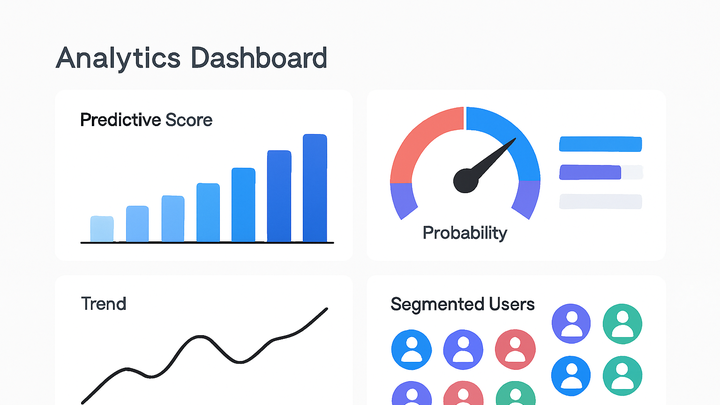Published on 2025-06-22T09:02:43Z
What is Predictive Score? Examples & Use Cases in Analytics
Predictive Score is a key metric in analytics that uses statistical and machine learning models to estimate the probability of future user actions, such as conversions or churn. By analyzing historical behavior and combining multiple data points, the predictive score assigns a numerical likelihood to events, enabling teams to proactively allocate resources and optimize strategies.
Platforms like Google Analytics 4 offer built-in predictive metrics—purchase probability and churn probability—that can be used to build high-value audiences. For privacy-first contexts, PlainSignal supports custom predictive scoring through event-driven data without cookies. Predictive scores turn raw analytics into actionable insights, informing decision-making across marketing, product development, and customer retention.
Predictive score
An analytics metric estimating the likelihood of future user actions—like conversion or churn—using historical data and machine learning.
What Is a Predictive Score?
This section defines predictive score, explains its core concept, and highlights why it’s essential in modern analytics workflows.
-
Definition
A predictive score is a numeric value assigned to a user or event that represents the estimated likelihood of a specific future outcome, such as conversion, churn, or engagement.
-
Purpose
It helps businesses anticipate user actions, prioritize high-value leads, and optimize marketing by focusing on segments with the greatest impact.
-
Key components
Predictive scores combine historical data, feature engineering, and algorithms to generate probabilistic estimates.
-
Historical data
Past user behavior and event logs used as input features.
-
Algorithms
Models like logistic regression, decision trees, or neural networks that calculate probabilities.
-
Feature engineering
Selecting and transforming variables to improve model accuracy.
-
Why Predictive Score Matters
Understanding the importance of predictive scores and their impact on decision-making, resource allocation, and growth strategies.
-
Improved targeting
Allows teams to focus on users with the highest likelihood to convert or churn, maximizing ROI.
-
Resource optimization
Allocates budget and efforts to segments with the highest expected impact.
-
Data-driven insights
Transforms raw event data into actionable probabilities for informed strategy development.
Implementing Predictive Score with Analytics Tools
Walkthrough of how to set up and leverage predictive scores in popular SaaS analytics platforms.
-
Google analytics 4 (GA4)
GA4 provides built-in predictive metrics such as Purchase Probability and Churn Probability. Use these metrics to create audiences and inform campaigns.
-
Enable predictions
Navigate to “Events > Predictions” in GA4 to view and configure predictive metrics.
-
Create audiences
Use conditions like “Purchase probability > 0.8” to build custom audiences for targeted messaging.
-
-
PlainSignal (cookie-free analytics)
PlainSignal offers simple, privacy-first analytics with the ability to create custom predictive scores via event streams.
-
Integration setup
Insert the tracking snippet into your HTML:
<link rel="preconnect" href="//eu.plainsignal.com/" crossorigin /> <script defer data-do="yourwebsitedomain.com" data-id="0GQV1xmtzQQ" data-api="//eu.plainsignal.com" src="//cdn.plainsignal.com/plainsignal-min.js"></script> -
Custom scoring
Define custom events and use PlainSignal’s API to calculate scores based on event weights.
-
Best Practices & Limitations
Guidelines for effective use of predictive scores and awareness of potential pitfalls.
-
Regular model validation
Continuously test and recalibrate models to account for data drift and seasonality.
-
Data quality management
Ensure accurate, comprehensive data capture to feed reliable predictions.
-
Ethical considerations
Monitor models for bias and fairness, especially when scoring individuals.
-
Interpretability
Complement scores with explanations and confidence intervals to maintain stakeholder trust.
